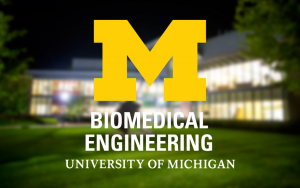Presented By: Biomedical Engineering
Microfluidics Seminar: Dr. Xufeng Xue
Stem cell-based modeling of human neurulation

Neurulation is a key embryonic developmental process that gives rise to neural tube (NT), the precursor structure that eventually develops into the central nervous system (CNS). Understanding the molecular mechanisms and morphogenetic events underlying human neurulation is important for the prevention and treatment of neural tube defects (NTDs) and neurodevelopmental disorders. However, animal models are limited in revealing many fundamental aspects of neurulation that are unique to human CNS development. Furthermore, the technical difficulty and ethical constraint in accessing neurulation-stage human embryos have significantly limited experimental investigations of early human CNS development.
I leveraged the developmental potential and self-organizing property of human pluripotent stem cells (hPSCs) in conjunction with 2D and 3D bioengineering tools to achieve the development of spatially patterned multicellular tissues that mimic certain aspects of human neurulation, including neuroectoderm patterning and dorsal-ventral (DV) patterning of NT.
In the first section, I report a micropatterned hPSC-based neuroectoderm model, wherein pre-patterned geometrical confinement induces emergent patterning of neuroepithelial (NE) and neural plate border (NPB) cells, mimicking neuroectoderm patterning during early neurulation. My data support the hypothesis that in this hPS cell-based neuroectoderm patterning model, two tissue-scale morphogenetic signals, cell shape and cytoskeletal contractile force, instruct NE / NPB patterning via BMP-SMAD signaling. This work provides evidence of tissue mechanics-guided neuroectoderm patterning and establishes a tractable model to study signaling crosstalk involving both biophysical and biochemical determinants in neuroectoderm patterning.
In the second section, I report a human NT development model, in which NT-like tissues, termed NE cysts, are generated in a bioengineered neurogenic environment through self-organization of hPSCs. DV patterning of NE cysts is achieved using retinoic acid and/or Sonic Hedgehog, featuring sequential emergence of the ventral floor plate, p3 and pMN domains in discrete, adjacent regions and dorsal territory that is progressively restricted to the opposite dorsal pole.
I leveraged the developmental potential and self-organizing property of human pluripotent stem cells (hPSCs) in conjunction with 2D and 3D bioengineering tools to achieve the development of spatially patterned multicellular tissues that mimic certain aspects of human neurulation, including neuroectoderm patterning and dorsal-ventral (DV) patterning of NT.
In the first section, I report a micropatterned hPSC-based neuroectoderm model, wherein pre-patterned geometrical confinement induces emergent patterning of neuroepithelial (NE) and neural plate border (NPB) cells, mimicking neuroectoderm patterning during early neurulation. My data support the hypothesis that in this hPS cell-based neuroectoderm patterning model, two tissue-scale morphogenetic signals, cell shape and cytoskeletal contractile force, instruct NE / NPB patterning via BMP-SMAD signaling. This work provides evidence of tissue mechanics-guided neuroectoderm patterning and establishes a tractable model to study signaling crosstalk involving both biophysical and biochemical determinants in neuroectoderm patterning.
In the second section, I report a human NT development model, in which NT-like tissues, termed NE cysts, are generated in a bioengineered neurogenic environment through self-organization of hPSCs. DV patterning of NE cysts is achieved using retinoic acid and/or Sonic Hedgehog, featuring sequential emergence of the ventral floor plate, p3 and pMN domains in discrete, adjacent regions and dorsal territory that is progressively restricted to the opposite dorsal pole.